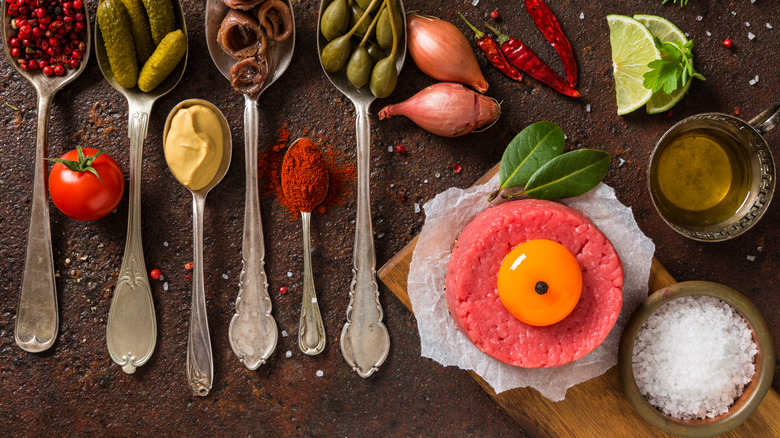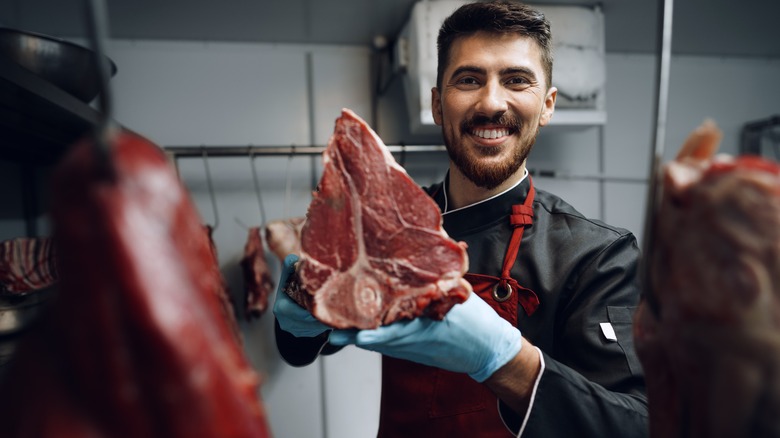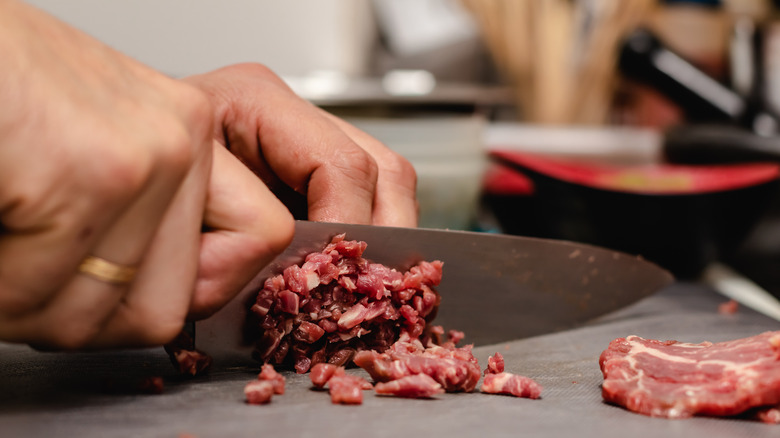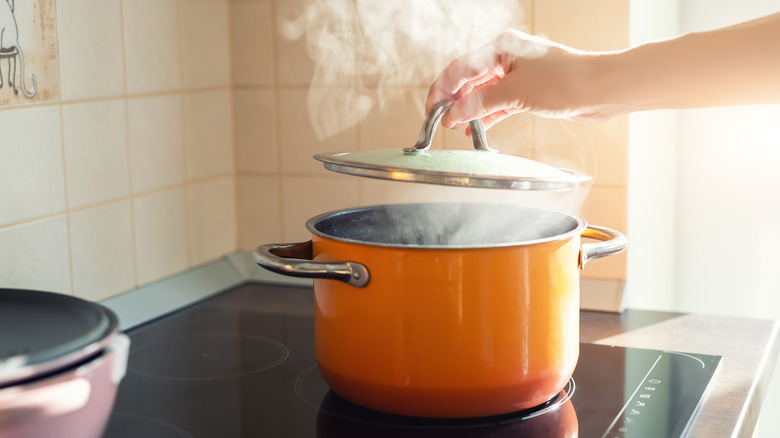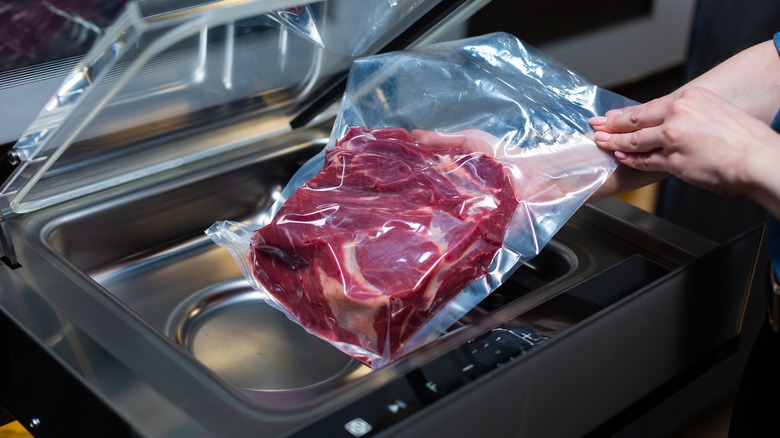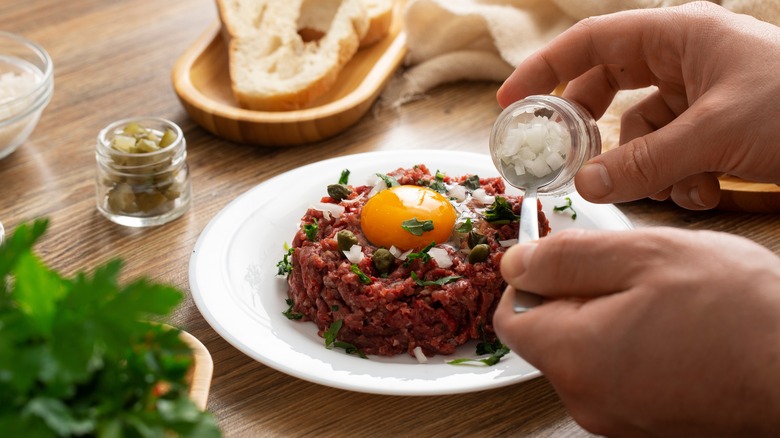How To Make Steak Tartare At Home Without Getting Food Poisoning
Steak tartare may conjure images of fine dining — a dish delicately garnished with an egg yolk and crostini — and perhaps for good reason. After all, if you're going to eat raw meat (which is essentially what a "tartare" is), you want it prepared carefully, and by food professionals held to high standards.
The stakes get raised (no food pun intended) when it comes to raw animal-based ingredients, whether it's fish in sushi, egg whites in a whiskey sour, or meat in a tartare. You're placing serious trust in the person preparing it, because, as noted by Healthline, consuming raw food can expose you to not-so-appetizing encounters with harmful bacteria, including E. coli and salmonella. It stands to reason that preparing such dishes in your own kitchen allows you to meticulously control the process.
While homemade sushi may not be everyone's forte, the same level of culinary expertise is not necessary to make steak tartare, nor are the knife skills. Different versions of steak tartare are visible around the world and throughout history. Even though there is no way to guarantee that it's completely germ-free (the Academy of Nutrition and Dietetics advises pregnant people, children, and those with compromised immune systems to avoid eating raw meat), a few precautions and an eye for detail can help minimize the risk of making and consuming this deceptively simple delicacy at home.
Sourcing the right beef
As a first step, your homemade steak tartare needs a delectable cut of meat. Sure, several dressing options will embellish it later, but the star of the show is the raw beef's subtle flavor, texture, and aroma. While tenderloin or filet mignon are generally the preferred cuts as they tend to be the most lean and tender, the beef's quality takes precedence over the actual cut. You're looking for a fresh, lean piece that's intensely red, firm, and has a gentle, appetizing smell.
This is not the time to settle for off-the-shelf cuts. Instead, head to a trusted local butcher, or find a meat shop that specializes in high-quality cuts. It's best to let the person behind the counter know that you plan to make tartare and let them guide you.
A good butcher will ensure that your cut of meat is handled with care to avoid cross-contamination. While there is no way to completely ensure disinfection, though sourcing from a single steak cut is a huge advantage in this regard, there are steps you can follow throughout the preparation to minimize risk. In the meantime, ensure the meat is refrigerated until you get down to the process. The USDA specifies the "danger zone" for raw meat as between 40 degrees and 140 degrees Fahrenheit, a range in which bacteria can grow most rapidly.
Mincing at home vs buying minced meat
When deciding whether to use store-bought ground beef or buy a steak and mince it yourself, the first thing to consider is where pathogens might be hiding. According to the McGill Office for Science and Society, disease-causing germs that live in animal intestines may be present on or near the surface of a steak, but will not penetrate deep into the meat. However, with ground meat, if any pathogens were present during the grinding process, they are now mixed in with the rest of the meat. If you're cooking it, then there's no problem. However, eating it raw is a whole different ball game.
So, your best bet is to get a prime slab of beef from a trusted butcher, and then mince it at home after thoroughly disinfecting your prep surfaces. Ensure your hands, knife, and cutting surfaces are washed, and wear gloves while handling the cut. While you may be tempted to use a food processor, exposing the beef to additional surfaces increases the risk of contamination, so skip the kitchen gadgets and use your best chef's knife. Also, it's generally a good idea to pop the meat into the freezer for about 15 minutes before cutting. This firms up the texture, making it easier to handle, and also prevents the beef from getting too warm during prep.
Quick water boil and pan sear methods
Chefs often use a quick and simple disinfecting method for steak tartare, which involves dropping your beef into a pot of boiling salted water for about 10 seconds, and then dipping it into an ice water bath to stop the cooking. After about a minute in the ice bath, you can run some cold water over the meat to wash off any salt, and then put it into the freezer for a few minutes to bring it to the ideal temperature and texture for working with. These steps may seem finicky, but when you're working on a dish that's this simple and has so few ingredients, the deliciousness lies in the details.
If you're serving your steak tartare with an egg yolk and plan on garnishing it atop an eggshell, this boiling water method should also be used to disinfect the shell before you place it on the meat. Another preparation step for making your steak tartare safe to eat involves searing the outside surfaces of the meat on a pan (or with a blowtorch à la crème brûlée, if you have one) and then cutting out the thin layer of charred meat. The underlying layer should still be raw enough for steak tartare, and now you've also got a snack on the side.
Sous vide method
The French cooking technique, sous vide can also help minimize risk when preparing your steak tartare. This involves sealing the food in specialized plastic pouches, and immersing it in a hot water bath held at a precise temperature.
It should be noted that while the USDA tends to be categorical in its general advisements, saying "raw meat is never safe to eat" and that beef steaks need a minimum of 145 degrees Fahrenheit to cook, these assume the most common cooking conditions and its advising with the highest degree of caution. What the headline figures don't explain is that many factors play into it. Because degrees in temperature is the factor being used to fight potential pathogens, more heat reduces risk, but so does time. For most cooked meats the USDA recognizes a 6.5-log to 7-log pathogen kill rate as safe (where 7 means even one pathogenic cell in 10,000,000 should be eliminated). Two hours of cooking at 130 degrees Fahrenheit still achieves 7-log lethality, and while fat can increase pathogenic resistance, you should be working with very lean cuts for tartare. While you wouldn't want to go with anything as fatty as ribeye, because sous vide also tenderizes the meat, it does allow you to choose from a wider range of cuts.
To pasteurize your (unminced) steak, submerge a sealed vacuum bag with your beef in a 130 degrees Fahrenheit sous vide bath for about 10 hours. Then, place it in an ice water bath for around 15 minutes, and refrigerate until it is ready to be cut.
More tips and what to watch out for
In addition to the methods above, simple practices can ensure your safety. First, minimize the time the meat sits on your counter. Frankly, it shouldn't sit on the counter at all. Refrigerate it immediately after purchasing, and once prepared, consume the steak tartare immediately. Should you get food poisoning, Mayo Clinic notes that pathogens like E. coli can cause unpleasant symptoms such as stomach pain, nausea, fever, and diarrhea. If symptoms persist or escalate, seek medical attention immediately.
However, there really shouldn't be anything stopping you from making a delectable steak tartare at home once you understand that while there is no way to be sure of complete sterilization, the occurrence of food poisoning from steak tartare is relatively low. Most places serving the dish take the required safety precautions, and as long as you do too, you can make steak tartare in your kitchen.
